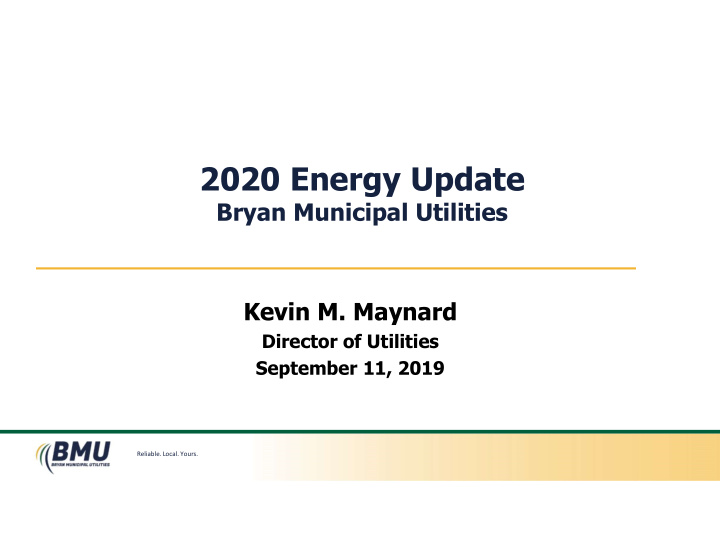



2020 Energy Update Bryan Municipal Utilities Kevin M. Maynard Director of Utilities September 11, 2019 Reliable. Local. Yours.
Bryan Municipal Utilities overview • Non-profit, community-owned utility services provider • Three primary services • Water—Established 1892 • Electricity—Established 1896 • Telecommunications—Established 1998 • 48 full-time and 13 part-time employees • 2018 revenues of approximately $26 million Reliable. Local. Yours. 2
Bryan Municipal Utilities overview Oversight provided by five- • member Board of Public Affairs Bryan residents elected by local – citizens to four-year, staggered terms Approve policies, staffing, budgets, – rates Authorize utility improvements and – extensions City Council approval of annual utilities – budget and debt issues required Bryan Board of Public Affairs Reliable. Local. Yours. 3
Water Utility Reliable. Local. Yours.
Focus on distribution system improvements • Approximately 70 miles of water distribution system mains • Assuming 100-year service life, approximately 0.7 miles (3,700 feet) of water mains must be replaced annually • Eliminate four-inch water mains and four-inch fire hydrants • Replace lead service lines within public rights-of-way • Requires approximately $750,000 annually • Improves service reliability • Increases firefighting capabilities • Helps ensure infrastructure is in place to effectively serve existing customers and for future economic development Reliable. Local. Yours. 5
Water Utility rate plan • Water rates generate sufficient revenue to meet O&M expenses but are not sufficient to fully fund annual capital improvement costs of approximately $1 million • In 2018, BPA adopted first phase of five-year water rate plan • Plan calls for water rate adjustments of approximately seven percent (7%) annually • Second phase of plan under review with recommendation presented for BPA consideration this fall • Water rates remain competitive with others in area Reliable. Local. Yours. 6
Enhanced groundwater monitoring • BMU has recorded groundwater levels since early 1950s – Continuous water level recorders at two local test wells – Data compiled by Ohio Dept. of Natural Resources (ODNR) – Weekly data collected at well field northwest of Bryan – Water quality data collected from 48 wells across Williams County during 1980s USGS study of local groundwater resources – At present, water quality data is not regularly collected except at municipal wells Reliable. Local. Yours. 7
Enhanced groundwater monitoring • Why does it matter? – Ohio law allows landowners “reasonable use” of groundwater unless withdrawals cause harm to others by lowering water tables or reducing artesian pressure – Data needed to demonstrate detrimental level changes – USGS and ODNR review increases credibility – Provides baseline data for detection of contamination, allowing time to plan and implement responses Reliable. Local. Yours. 8
Enhanced groundwater monitoring • Delineate 10-year groundwater time of travel zone and develop a monitoring well network and water quality analysis parameters designed to provide early detection of changes in water quality and groundwater levels • Upgraded water level recorder at Power Plant test well provides real-time water level data reviewed by USGS hydrologists and posted on USGS website • https://waterdata.usgs.gov/oh/nwis/uv/ Reliable. Local. Yours. 9
Enhanced groundwater monitoring • Expand groundwater level data collection by installing a continuous groundwater level recorder at West Well Field test well • Work with others to expand data collection across aquifer area Reliable. Local. Yours. 10
Recommend
More recommend